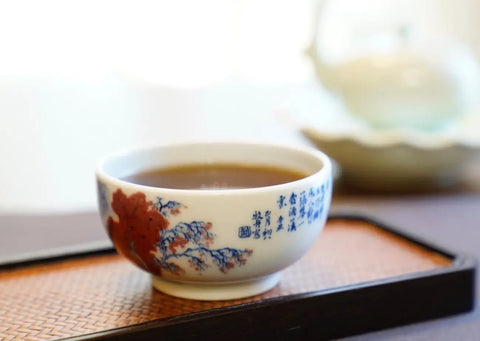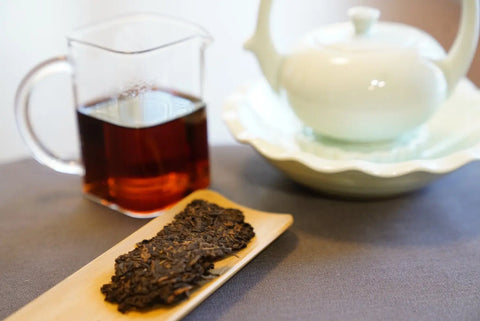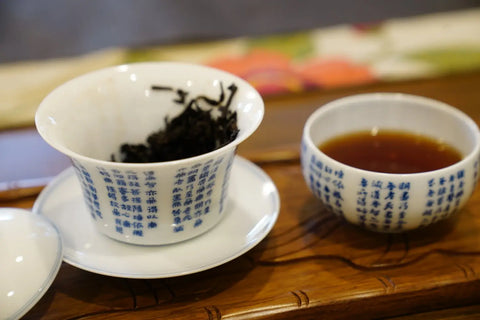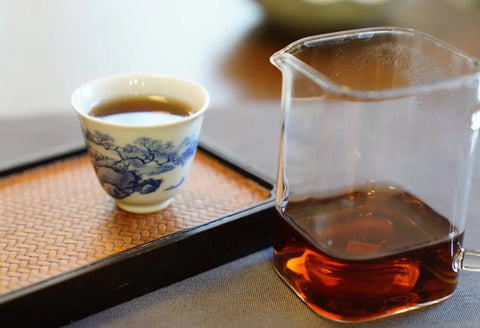
The Right Way To Brew a Great Cup of Shu Pu-erh Tea
Shu puerh tea undergoes a fermentation process which creates that unique shu flavor profile. While sheng puerh tea in general creates a stronger sensation, shu puerh in general is mellower and milder, and the taste has more consistency throughout all its steeping sessions. However, if it is not brewed correctly, the taste can be very flat and boring, resulting in a less satisfying cup. In this blog, we break down the important factors that are commonly overlooked in the brewing process.

Here, we outline a simplified gongfu brewing guide for shu puerh tea (also suitable for sheng puerh):
- Choose your brewing vessel. Either Yixing Zisha teapots or porcelain teapots are a good choice, and a porcelain gaiwan is also acceptable. A glass teapot or a glass mug is not recommended for brewing shu puerh tea.
- Weigh your tea on a scale. The preferred leaf to water ratio is 1:30.
- Use hot water to warm up your vessel first, then add the tea. Just a reminder, please never, ever use tap water. Always use spring water or filtered water.
- Quickly rinse the tea. Pour hot water into the teapot to rinse and quickly empty it.
- Always pour all the tea out of the teapot, using your fair cup to hold any excess tea.
- Steeping time varies depending on your preference. The rule of thumb is to divide the gongfu session into three mini sessions, with the first mini session composed of several shorter steeps, steeping 15 seconds longer for the second session and 30 seconds more for the last, creating an evenly flavorful liquor.
We do believe that brewing a great cup of tea is an art that can be mastered, although following this outline does not guarantee a perfect cup as there are many other factors that may influence the outcome. Here we outline some common factors outside of this foundational routine that may affect your cup of tea and explain the reasons behind the good practice.

- Why do we want to “wake up” the tea?
Most puerh teas are in the form of pressed cakes or bricks and stored for several years or decades before reaching consumers. When this tea is abruptly “awoken” from its dormant state, it may unpredictably impact the tea, so we need to be gentle and considerate. If you can plan ahead for your tea session, store the leaves pried from the cake in a jar for a day to a week. At the start of brewing session, the first steep is best not to be served, but for purposefully “waking up” this sleeping beauty. The key here is to pour the hot water gently into the pot and quickly pour out the water.
- Does water temperature really make a big difference?
Yes. We recommend steeping in 210 degrees water. A high temperature forces the substances in the tea to release and brings out optimal aroma and flavor. Of course, this works in an inverse manner for bad teas, revealing its undesirable quality and taste. Thus, it may be dubious for one to recommend lower water temperatures to brew shu puerh, as some even suggest as low as 185 degrees. Lower brewing temperatures can mask the bad taste of a poor-quality Shu. Indeed, an optimal temperature is important for any tea brewing. We do not brew shu puerh in less than 200 degrees of water.
Pounding the table: Don’t repeatedly boil the same water many times, as oxygen in the water dissipates after being boiled over and over, and trust me, it will affect your tea taste.

- How much tea do you need?
While a leaf to water ratio of 1g for 30ml water is recommended, there is no definitive rule. This depends on your personal taste and preference. If you prefer a stronger flavor, you can add more tea. Otherwise, use less tea if you prefer a softer taste. Alternatively, you can brew your tea a little bit longer or shorter. You are the designer of how you want your tea to taste. Also, consider the size of your teapot and how many people you are serving.
- Always use your fair cup
Never let your tea sit in the teapot after brewing. If you do so, it is almost guaranteed that your tea will not taste as good as it should. A rule of thumb is to always pour the entire brew into your fair cup or pitcher. These vessels are present at the tea table for a reason and are at hand to serve you.
- How many times can you brew your puerh tea?
Remember, your tea is not from a tea bag, where you just brew it once and throw it away. Maximize the benefits and get the most enjoyment out of your favorite tea by steeping as many times as possible. You will be surprised at how many long your tea can be sustained. As an example, for our Award-winning Vintage 2004 Bliss Shu puer cake, we sometimes brew as many as 30 times per session! Even though the tea flavor fades a bit for the last several steepings, the water is still sweet and pleasant to drink. This is the beauty of a quality shu puerh tea, and makes it worth the purchase price.

- Last but not the least, put yourself in a good mood and be mindful in the brewing, with a nice peaceful environment.
We recommend having a tea table or a designated area for tea with your favorite surroundings. A flower arrangement, a painting, or some nice tea ware will elicit a pleasant mood for your tea session. Remember, you are the biggest influencer of your tea enjoyment. Your focus and serenity will give your tea the boost it needs to release its full potential. If you are in a hurry, or thinking about other things while steeping, your tea will not taste great as it should. It is best to be in a normal state of mind, calm and peaceful, focusing on the tea in the moment, respecting the tea and treating it like an old friend, and you will be rewarded with a great cup of tea and fully enjoy the process.

Johnny Oolong on
Am I missing something or does this post really never state how long the first steep should be?